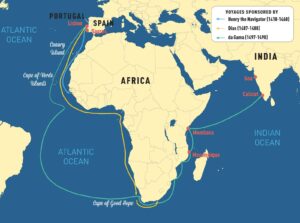In Malawi, nine-year-old Christopher struggles to keep up in school, likely due to cognitive delays caused by ongoing nutritional deficiencies throughout his childhood. In California,…
There are 54 countries in the African continent; Zambia shares its borders with eight of them. Located in the southern part of Africa, Zambia ranks as the 17th largest country on the continent.
A Brief History of Zambia
When Portuguese sailors embarked on their Age of Discovery around the continent of Africa in the 15th and 16thcenturies, they brought with them new foods from the Americas. They offered goods in exchange for slaves. Not wanting to hand over their own people, the African rulers began raiding other tribes to have slaves to sell to the Portuguese.
In 1851, a British missionary named David Livingstone came to Zambia, which was known as Northern Rhodesia at the time. His purpose in coming was to convert the Africans and to put an end to the slave trade. Ultimately, his plan to replace the slave trade with legitimate commerce failed due to the difficulty in transporting goods from Northern Rhodesia to Mozambique for export.
During the end of the 19th century, Northern Rhodesia came under British rule for a short period of time. The British South African Company was established to capitalize on what it expected was great mineral wealth in southern Africa.

The Discovery of Copper andIndependence for Zambia
It wasn’t until the late 1920s when rich underground deposits of copper were discovered in the northern part of modern-day Zambia. By 1939, Northern Rhodesia was the world’s main source of copper, inspiring a surge in European settlers, but not nearly as many as what the British government hoped for.
Also during the 1930s, there were a growing number of British schools in Northern Rhodesia. More educated Africans meant better job opportunities and the creation of welfare associations.
In 1953, the British government created the Federation of Rhodesia and Nyasaland to try to maintain European power over the three main African colonies in the area. The Federation—comprising the land now known as Zambia, Zimbabwe, and Malawi—lasted ten years before it was dissolved. Northern Rhodesia gained its independence from British rule in October 1964 and was renamed Zambia after the Zambezi River, the fourth longest river in Africa and the location of Victoria Falls, one of the world’s largest waterfalls.
Poverty in Zambia
Despite its potential for great wealth, Zambia struggled. It’s reliance on the copper industry meant that the economy rose and fell with the price of copper. When the price of copper fell in the 1970s, Zambia was forced to borrow money, falling deeper and deeper into debt.
Today, Zambia is still considered a developing country. In the early part of the 21st century, Zambia’s economy was considered one of the fastest growing economies in Africa, but that growth has slowed.
Additionally, almost half of Zambia’s population live in urban areas, where the population is high and the income is low. Since much of the urban expansion was unplanned, many people have ended up living in informal housing compounds, known as kombonis in Zambia.
An estimated 60% of Zambia’s population currently lives below the poverty line—earning less than $2.15 per day—and families often have many children to support. Zambia’s fertility rate ranks among the highest in the world, with woman giving birth to an average of six children.
While education in Zambia is free, many families cannot afford to buy the books and other supplies required to attend. School buses are not available everywhere, and children may have to walk very long distances to get to the nearest school. Many of these children drop out of school before reaching the seventh grade and start working to help their families cover their expenses.
Children who complete their education are more likely to gain knowledge and skills that will allow them to earn higher incomes. Without this education, children living in poverty are more likely to go into the same low-income labor as their parents, thereby continuing the cycle of poverty.
Children’s Hunger Fund in Zambia
In 2015, Children’s Hunger Fund (CHF) partnered with Pastor Conrad Mbewe and Kabwata Baptist Church to create a Mercy Network of churches in Zambia. CHF supports the work being done by these 13 local churches by providing mercy ministry training and resources as they seek to serve the poor in a Christ-centered way.
In 2022, construction was completed on a Mercy Center in Lusaka, a multi-use facility designed to expand the capacity of our church partners to impact their community. The Mercy Center serves a total of 205 students—128 girls and 77 boys. The completed Mercy Center expanded the four-classroom school connected to Kabanana Faith Baptist Church to include nine classrooms, newly built restrooms, an office space, and storage space. The Mercy Center also offers an outreach ministry for street kids, after-school care and activities, community evangelism, Sunday school, and discipleship courses.
Before the Mercy Center was built, Pastor Curtis Chirwa at Kabanana Faith Baptist Church shared that space was limited. He wanted the kids to have a safe space to play soccer, but he wanted the students to be able to look outside of the slum that surrounded the church and dream about what their life could be. The two-story Mercy Center has not only provided these students with a place to learn but a way to see a future beyond their poverty. Thanks to the faithful pastors and church volunteers of the Mercy Network churches in Zambia and the generosity of our supporters, this future can become a reality.







